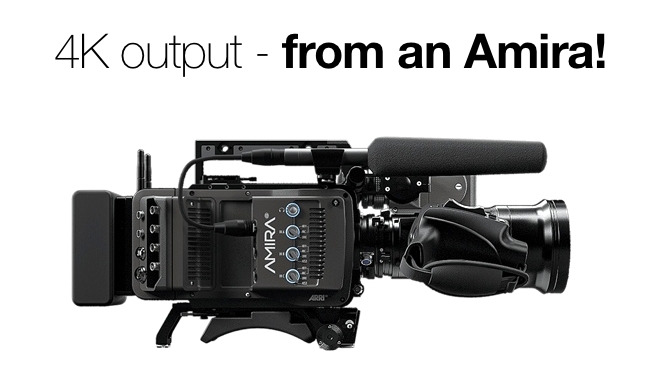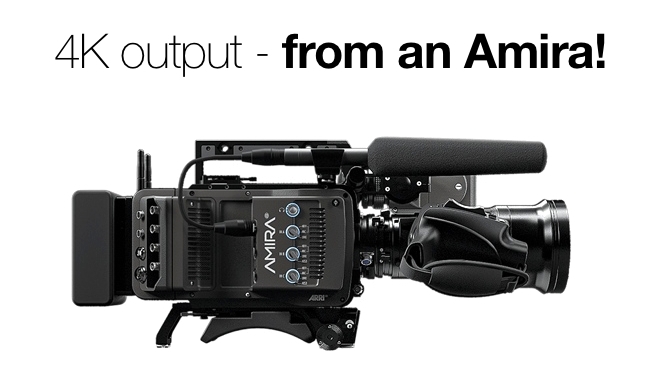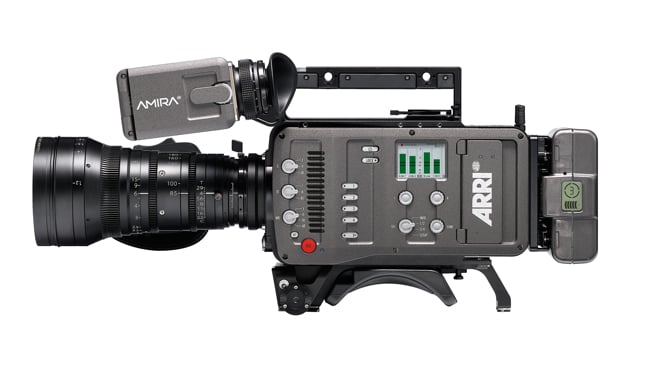
 4K output from an Amira
4K output from an Amira
In a statement released today (and reproduced below in full) ARRI has announced that its Amira camera will can be upgraded to record UHD (not 4K) internally, as UHDProRes
This is a big surprise, not least because the Amira doesn't have a 4K sensor: it's got the same sensor as in the acclaimed Alexa. You can't upgrade a camera that doesn't have a 4K sensor to 4K.
Despite not having a native 4K (or UHD) sensor, both of these cameras - especially the cinema-oriented Alexa - have been used to make a large number of films that are mastered and distributed in 4K.
Some way through the press release, you'll see that the real story is that the output from the Amira's less-than-UHD sensor is upscaled internally by the camera and then recorded in 4K ProRes. So the Amira's not having its resolution increased - just upscaled.
So, on the face of it, no big deal then. It's a clever piece of engineering that solves a problem: how do you deliver UHD from an Amira quickly, without the need for upscaling in Post?
It's when you stop and think about this that it begins to feel a bit unsettling, especially if you're used to the doctrine that says something like "increased resolution is a prerequisite of better pictures".
Most companies are trying to do the opposite!
It's even more confusing when you realise that most companies are trying to achieve almost the opposite of what ARRI has done with the Amira: they're building sensors with much higher resolution and downsizing to 4K, and it's how they do this that has the biggest effect on the overall quality of the picture. Think of how a Canon 5D mk III's image is obtained from its 22.3 megapixel sensor - by "line skipping" vs how the Alpha 5S uses information from ever pixel to create an HD or 4K image.
And don't forget that having a sensor with 4K resolution (ie at least 8 megapixels) doesn't guarantee a true 4K output, because sensors only "sense" light and dark. To get colour from they you have to overlay a "Bayer" filter, which dedicates certain pixels to certain colours, in a pattern that enables a true colour picture to be calculated through a process called "Debayering". But doing this means that you won't get a picture at the same resolution as the sensor. Arguably to get true 4K, you'd need a sensor with a much higher resolution, like the 8K one in Sony's F65.

The biggest ripple this will make is that people will have to acknowledge that resolution isn't everything. It's just - literally - part of the overall picture. Just as important - and quite possibly more so - are factors like contrast, colour depth and the overall "look" of the pictures.
Remember that 4K (or UHD) is really hard to achieve, even with a 4K camera! You have to have it absolutely in focus, and completely still. Anything that degrades the image - even by half a pixel - will turn it back into HD or below.
So starting from a position of strength, with an image that virtually the whole industry agrees is superb, and then upconverting to give a 4K (or UHD) deliverable, makes complete sense.
We think this is a clever move by ARRI and one that will challenge the rest of the industry to define what it really means by 4K and UHD.
ARRI press release in full after the break
(August 26th 2014, Munich) – A new software upgrade for ARRI’s documentary-style AMIRA camera will allow it to record ProRes UHD files, answering the 4K requirements of some productions. The upgrade is expected to be available for purchase at the online ARRI License Shop by the end of 2014.
DELIVER ANY FORMAT
While widespread adoption of 4K or UHD for broadcast is still a long way off, an increasing number of content owners are becoming concerned that they ought to safeguard the longevity of their programs by ensuring that they will be suitable for UHD transmission, should that become a standard in the future.
For those productions that do need to generate UHD deliverables, AMIRA will now offer the ability to record all ProRes codecs in Ultra High Definition 3840 x 2160 resolution directly onto the in-camera CFast 2.0 cards, at up to 60 fps. This feature, activated through an affordable software license (and a sensor calibration for existing AMIRAs), comes in response to feedback from AMIRA customers, some of whom have been quizzed about 4K deliverables by clients. It is made possible by the camera’s exceptional image quality, its processing power, and its reprogrammable system architecture.
Whether a production is pursuing a UHD workflow all the way through to distribution, or simply wishes to archive in UHD in order to future-proof itself against industry developments, AMIRA now offers an easy solution that requires no additional processes in postproduction.
IN-CAMERA PROCESSING
The ALEXA/AMIRA sensor has repeatedly proved its ability to deliver outstanding image quality for the 4K or even IMAX theatrical releases of high-end feature films such as Gravity, Maleficent and Iron Man 3. This proves that the ALEXA and AMIRA camera systems are already future-proof and more than suitable for the next generation of distribution formats.
For major feature films, an up-sample to 4K can be carried out after visual effects and other postproduction tasks have been completed at 2K resolution. For certain fast-paced AMIRA productions, however, there may not be the time or resources for such processes in post, which is why a 4K or UHD output direct from the camera has been requested.
AMIRA’s UHD output utilizes the same efficient 1.2x up-sample filter that allows ALEXA’s Open Gate mode to optimize the camera’s image performance for 4K distribution, as well as the same best-in-class sensor pixels. The up-sample to UHD happens in camera, and in real time.
SAME GREAT IMAGE QUALITY
Outputting UHD broadens the distribution options for the superior image quality that has helped make AMIRA, and ALEXA, such a success. The wide, 14+-stop dynamic range remains unaltered, as does the accurate colorimetry, natural skin tones, and organic look and feel. By making that high-quality image data coming out of the sensor compatible with higher spatial resolution formats, the UHD upgrade answers the concerns of certain regions and productions about a 4K future, allowing AMIRA to be used on any project, no matter what deliverables are required.
Markus Duerr, ARRI’s Product Manager for the AMIRA system, says, “Feedback about AMIRA from all over the world has been overwhelmingly positive and it is clear that the camera is already a great success, being used on an amazing variety of challenging productions. Already acclaimed for its phenomenal image quality, ease of use and versatility, the new ProRes UHD output will take these benefits even further, adding value for customers in areas like China, where 4K is a major focus of industry attention.”
Wildlife cinematographer Rolf Steinmann, who was nominated for an Emmy Award this year in recognition of his work with ALEXA on the BBC’s Wild Arabia series, is currently using his AMIRA on a movie for Disney Nature. He comments, "For cameramen like me who own their gear, the UHD upgrade is a great way to stay future-proof. From now on when there's pressure from the production side to deliver UHD, I can continue to work with AMIRA and won't have to compromise on image quality or on the camera's robustness and reliability."
About ARRI:
With headquarters located in Munich, Germany, Arnold and Richter Cine Technik (A&R) was founded in 1917 and is the world's largest manufacturer and distributor of motion picture camera, digital intermediate (DI) and lighting equipment. The ARRI Group comprises a global network of subsidiaries and partners that covers every facet of the film industry, including worldwide camera, grip and lighting equipment rental through ARRI Rental; turnkey lighting solutions through the ARRI System Group; lab services, postproduction and visual effects through ARRI Film & TV; and film distribution through ARRI Worldsales. Manufactured products include the ALEXA camera system and AMIRA documentary-style camera; Master Anamorphic lenses; L-Series LED and M-Series HMI lights; Pro Camera Accessories; and ARRISCAN archive technologies. The Academy of Motion Picture Arts and Sciences has recognized ARRI’s engineers and their technical contributions with 18 Scientific and Engineering Awards.
For locations and more information please visit www.arri.com
Tags: Technology


Comments